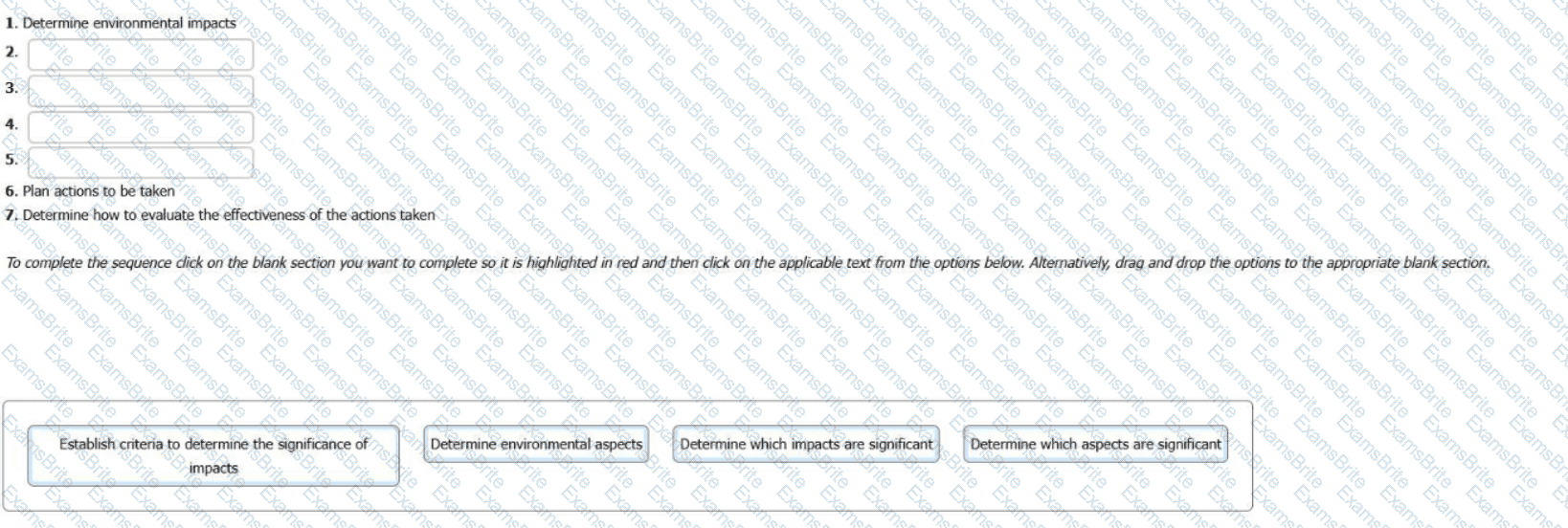
PECB Certified EMS ISO 14001 Lead Auditor Exam
Last Update Nov 30, 2025
Total Questions : 40
We are offering FREE ISO-14001-Lead-Auditor PECB exam questions. All you do is to just go and sign up. Give your details, prepare ISO-14001-Lead-Auditor free exam questions and then go for complete pool of PECB Certified EMS ISO 14001 Lead Auditor Exam test questions that will help you more.



Whistlekleen is a national dry cleaning and laundry organisation with 50 shops. You are conducting an EMS surveillance audit of Head Office and are sampling environmental performance measurement. You find that 80 per cent of failures to meet performance criteria originate from five shops in the same region. Most of these failures relate to the release of volatile organic compounds (VOCs) that exceeds regulations. The Environmental Manager tells you that these are the oldest shops in the organisation. The cleaning equipment needs replacing but the organisation cannot afford it at the moment.
On raising the matter with senior management, you are told that there are plans to replace the equipment in these shops over the next five years.
Select two options that apply to how you should respond to the information given.
Which one of the following outcomes of an audit does not require the auditee to respond?
Which two of the following documents are not required for documentation review by an auditor conducting a Stage 1 certification audit to ISO 14001?
Considering the requirements of clauses 6.1.2 and 6.1.4 of ISO 14001:2015, put the actions in the correct order to complete a process/task.

An internal auditor of a manufacturer of aluminium products for the car industry raised a nonconformity against section 6.2.2 of ISO 14001 in Report IA202. The nonconformity (NC3) stated:
"Top management has not analysed why none of the environmental objectives set for the last year have been met."
A third-party auditor reviewing the internal audit process came across the nonconformity and found that no corrective action was documented. The EMS Manager confirmed no action had been taken, but added he expected a number of objectives to be achieved in the next three months so there was no need for further action. He explained in confidence that the organisation was fighting a takeover bid and resources for environmental projects had been cut.
From the information, select three non-conformities options that the auditor could raise to ISO 14001.
ABC is a large lubricant oils manufacturer located in country A. Due to tax exemption and other economic issues, they decided to move the whole plant to a neighbouring country B. They moved every single piece of the plant (equipment, systems); the new plant has the same layout, the same dimensions, the same suppliers of raw materials and the same customers. Even more, most personnel accepted to move to country B.
They operate a third-party certified EMS; the certificate was transferred to the new plant after a half-day audit from the certification body. You are auditing ABC's EMS in the new location, representing ABC's largest customer. When interviewing the Environmental Manager (EM), you ask:
You: Can I see the plan you developed to keep under control the impact of the EMS due to the change of site?
EM: We listed all elements and processes of the EMS that might need to be changed and selected those that we considered needed a careful review and probably a revision.
Below you will find that list; select six that you consider will need to be revised.
A small services organisation has been contracted to handle the disposal of waste for a local hospital. You are an auditor conducting a Stage 2 audit of the care home to ISO 14001. You are reviewing the contract with the Service Manager (SM). An addendum to the contract only requires that biological waste is disposed of in the most environmentally friendly way, without reference to any regulatory requirements.
You: How was the waste disposal plan for the contract developed?
SM: We have a basic template that covers the materials, labour requirements and methods to be employed. Some of that is specified by the contractor.
You: How does the plan deal with specific items like biological waste, which are included in the contract and can pose biological hazards to the environment?
SM: The basic plan covers general waste, but we have an addendum that covers biological waste.
You: Are you aware of the regulatory requirements for waste disposal standards in hospitals?
SM: Yes but we depend on the contractor to look after that side of things.
You raise a nonconformity against section 8.1.d of ISO 14001.
At the Stage 2 closing meeting of the audit, the EMS Manager objects to the nonconformity raised and asks for it to be withdrawn. He insists that they meet all the regulations.
Choose one of the options that the audit team leader should take in response to the request.
The audit lifecycle describes the ISO 19011 process for conducting an individual audit.
Which two of the following are part of conducting the audit activities?
Showitoff is an organisation specialising in the design and production of wall decorating materials for the domestic market. During an ISO 14001 certification audit of the site, the auditor comes across an open, walled area just outside the maintenance department. It contains various scraps of wood and metal as well as several rusty components. They are lying on an oily floor. When asked about it, the EMS Manager states that he presumes that the materials come from maintenance work.
The auditor interviews the Maintenance Manager in his department. He notes that shelves containing various spares are well labelled and neatly stacked. He asked about the "dump" outside and is told that it contains some excess materials that the Manager likes to keep in case they come in handy at some stage. The auditor points out that the "dump" might be classed under regulations as a landfill site, which requires an operating licence. The Maintenance Manager is not aware of such a licence.
The auditor decides to review the process for evaluation of compliance with environmental regulations in more depth.
Select three options that provide a meaningful audit trail for this process.
A group of 22 Italian restaurants in downtown San Francisco (US) established an EMS following the requirements of ISO 14001. You are performing an internal audit before the fourth certification cycle. The audit plan included an audit of the General Manager (GM) as the last interview before the closing meeting. During the interview with the GM, you audit clause 10.3 (Continual improvement). The dialogue is as follows.
You: Could you please tell me how did you improve the EMS to enhance environmental performance (Clause 10.3)?
GM: One way to improve the EMS is to improve one or several of its processes. We decided to improve the water-consuming processes in all our branches. We use water in many of our processes (e.g. to wash our kitchens, our cutlery, plates, and glasses, to keep our floors clean). The idea was to review these processes in detail to reduce the amount of water used per customer. Each of the 22 branches sent us their results, we analysed the data and found out that the average water consumption per customer was reduced by 13%; therefore, we improved our environmental performance. We are happy about that.
You: What about the results in each branch?
GM: Have a look at this table:

Analysing this table, what would be your decision related to raising nonconformities to clause 10.3? Select two.
Sparkle is an organisation that provides mobile car cleaning services at customers' premises. It has been certified to ISO 14001 for some time and has appointed a new EMS Manager. The audit plan during a surveillance audit includes the improvement actions and the auditor asks to see the most recent management review meeting minutes.
Which six statements would represent output audit evidence for the management review?